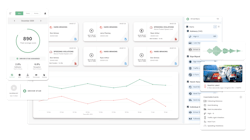While legislators and government agencies continue their focus on regulations, the vital and valuable role that safety and management technologies can play collectively are well-known to system and solution providers. In many ways, those companies and their carrier customers already are taking advantage of ways to use their systems to markedly improve safety.
Tiffany Giekes, product manager of LoadMaster at McLeod Software, pointed out the value when carriers can see how operational data correlates with safety, including information from third-party technology vendors.
“By having [transportation management system] and safety data linked, there is the ability to determine a potential safety risk,” Giekes said. “If the two data elements are not aggregated, it is easy to overlook potentially negative impacts on the safety of the fleet.”
For example, she noted that the TMS provider’s safety module allows carriers to see how the risk of a safety incident drastically increases across something like a lane that runs through a mountain range. “That can allow carriers to have candid conversations with shippers on how certain lanes need to be evaluated differently for safety concerns,” Giekes added.
“Motor carriers who maintain safety records in their TMS have an easy way to review their safety progress in many different areas,” said Robert Brothers, VP of product development at McLeod Software. “They can use this data during insurance renewal negotiations, as the basis for their safety culture in court cases, and to help reduce fines and violations.”
When combined with safety trends and information on driver training and qualification, the operational information in a TMS can be used to take proactive steps to reduce risk, noted Chris Orban, VP of TMS product management at Trimble. Here are some examples of successful TMS and safety initiatives that he provided:A winter weather program that identifies areas of risk proactively and routes drivers around storms to avoid weather-related accidents.
A system that identifies drivers who are likely to have minor incidents (which often led to more severe accidents in the future) and allow for additional training and route guides.
A system that utilizes hard braking and roll stability control event data to provide improved routing via the TMS to avoid areas that tend to be associated with those types of unsafe events.
A system that combines hours of service and location and critical event information to identify drivers who might be at risk of a fatigue related incident.
Fleets are utilizing existing technology on their trucks and trailers to gain insights, noted Benjamin Brown, VP of key account management, trailer and digital sales, commercial vehicle solutions, for commercial vehicle systems supplier ZF Group.
“Their primary goal is to ensure the equipment is performing correctly, which can be validated via a TMS providing real-time data and visual alerts to the driver and the back office,” Brown said. “As the industry continues to innovate, additional data sources are being developed to build on the existing infrastructure.”
“Fleets are using data from different technologies in their trucks to address areas of concern with drivers,” added Andrew Diesel, sales director of safety solutions at Drivewyze. “For example, if they are getting data around speeding, they may choose to send out fleetwide messaging on speed management and provide drivers with some of their internal statistics around violations and related accidents” and how these affect the company’s Compliance, Safety, Accountability/Inspection Selection System scores, profits and losses, and the like.
“With technologies, we can provide proactive in-cab safety notifications and data that can serve as an indication of issues drivers are having on the road and if they are changing their behavior,” Diesel added.Deeper dive into driver data
Chris Moore, product manager at Solera, pointed out that fleet managers can leverage data that provides insight into driver behavior, compliance, and risk assessment. “It can numerically break down driver behaviors and alert fleets and provide feedback to drivers on how to improve,” he said.
“However, this is just the tip of the iceberg when looking at benefits in terms of safety improvement,” Moore continued. “Data can also assist with training, ensuring compliance with regulations, and by leveraging data on routine fleet operations, carriers can gain valuable insights and implement strategies to ensure enhanced safety.”
Until recently, TMS safety benefits were limited to traditional vehicle telematics functions such as monitoring driving hours to reduce fatigue-related risks, Tim Crespin, director of product management at Nauto, explained. Telematics then extended from asset tracking into safety-related activities such as acceleration, braking, cornering, and speed.
“Although these provide indirect glimpses into driving, collision risk science suggests that traditional telematics features alone address at most 19% of total collision risk,” Crespin added. “Today, top-tier safety solutions are created by AI-native, safety-first developers and perform way beyond the extensions of existing technology.”
Using a driver fatigue example, Crespin noted how AI safety systems use computer vision to detect driver drowsiness. For example, advanced systems analyze symptoms such as shifting posture and head bobbing to measure fatigue before it reaches extreme levels. These fast and accurate detection technologies use computing power to warn drivers of extreme risks, such as impending collisions, before it is too late.
“Today’s systems provide full data dimensionality in risk detection and reporting, enabling transportation management systems to assess collision risks for a given driver, geo-location, or fleet,” Crespin added. “Scoring systems developed through billions of AI-analyzed miles are predictive about collisions. Managers can now gauge improvements in collision risk overall and then optimize operations accordingly.”
“Fleets are using data from safety technologies to improve their driver incentive programs,” Austin Schmidt, director of marketing at advanced AI fleet dashcam maker Netradyne, explained. “Bringing safety scores into a TMS and driver-facing applications makes it easier for drivers to understand how they’re tracking toward their bonus. Safety data is also being used to simplify and improve the training experience.”
Safety technologies can generate valuable data, which is broadcast on a vehicle communication network and transformed into actionable information, noted TJ Thomas, director of marketing and customer solutions-controls at Bendix Commercial Vehicle Systems.
“Fleets can analyze the data to create an indication of what happened during an event because it can show important aspects,” Thomas added. “They can use that information to identify at-risk drivers earlier for training and uncover ways to make their operations more efficient.”
For Jeff Martin, VP of global sales strategy at Lytx, a provider of video telematics and fleet management solutions, having safety data is crucial for making knowledgeable decisions and realizing results. The data on driver behavior enables a fleet to create a holistic profile, and hours-of-service data ensures compliance with both company policies and regulations, Martin said.
“Having this kind of data at your fingertips in a TMS leads to measurable results in fewer collisions and lower claims costs, violations, and penalties,” he continues. “Coaches and supervisors are better able to focus on drivers who need training and have the right conversation at the right time for the right reason to improve safe driving behaviors.”
Martin added: “With effective approaches, companies are better positioned to improve safety, while using data can also enhance efficiency and customer service. It's a total value opportunity when companies use data as the foundation of continuous improvement.”APIs play a key role
Open APIs, or application programming interfaces, facilitate the integration process by providing standardized, predefined methods for how software applications and systems exchange data in a consistent and compatible format, explained Nauto’s Crespin.
“They provide developers with documentation and examples to program common tasks without having to build custom integrations from scratch,” he added. “This speeds and facilitates common integrations, allowing them to focus on higher-level functionality."
“Open APIs are interoperable, in that they can be used to exchange data seamlessly between different systems and platforms regardless of their underlying technology stack,” Crespin continued. “They are also scalable, not only in terms of data volume but also for supporting multiple partnerships without getting bogged down in excess complexity from multiple customizations.”
“Ideally, open APIs provide flexible options for data retrieval, manipulation, and synchronization, so developers can tailor integrations to their specific requirements,” Crespin added. “When open APIs are the foundation, joint development delivers high-quality TMS and safety system integrations.”
For ZF Group’s Benjamin Brown, API technology is needed to effectively share data between disparate systems and third-party applications. “They deliver a reliable end-user experience,” he added, “and play a vital role in the ability to work efficiently both internally and externally to meet the increasingly complex demands of the market.”
Open APIs can enhance the ability to ingest multiple data points, weigh them based off frequency and severity, and then establish thresholds that trigger actions, Drivewyze’s Andrew Diesel related. “In a perfect world, fleets would use open APIs from all their technologies and bring them together in an efficient way that makes all the data not too overwhelming,” he added. “Another byproduct of this would be having easily accessible actionable data from each technology.”
Solera’s Chris Moore said APIs are becoming increasingly important for fleet management because they allow different software systems to communicate better and enable seamless data transfer.
“That leads to richer application use and not having to reinvent the wheel each time,” Moore stated. “It creates flow and promotes greater flexibility and customization, leading to more efficient operations. As APIs become more advanced, we can expect to see greater adoption to enhance fleet management and create a more data-driven industry.”
“Open APIs are very important for letting carriers use their own data in flexible ways,” said Netradyne’s Austin Schmidt. “With them we can allow customers to build their ideal technology stack.”
Lytx's Jeff Martin pointed out that there are other reasons to leverage an open API infrastructure, including the ability to:
- Consolidate devices in the vehicle and simplify data collection.
- Apply the power of big data, video, and artificial intelligence to solutions with low development costs.
- Seamlessly integrate with application providers and enterprise systems.
- Build custom solutions to meet exact requirements.
See also: Lytx report shows improved truck driver safety despite increasingly hazardous roadways
APIs allow for real-time updates to safety and operational data, according to Tiffany Giekes at McLeod. Using partner APIs in a TMS also lets carriers control how often the data is transmitted, even allowing for real-time analytics on safety performance.
“For partners, prebuilt APIs for specific safety solutions provide easier access to a TMS provider’s customers,” McLeod’s Robert Brothers, VP of product development, added. “They play a vital role in showing when and how much data is accessed, and they give our customers control what data can be accessed. That’s one reason we’re building out our partner APIs.”
Chris Orban at Trimble noted as well that open APIs delivered via a TMS provider’s developer network enable faster connectivity and integration. “By having clear documentation and well-defined endpoints,” he added, “we can integrate with current and future safety management platforms.”
TMS, safety system suppliers team up
“As we standardize data, integrations become much more streamlined,” Orban continued. “Enabling straightforward integrations from a variety of products provides for data that safety and operational management systems need.”
Integrations between TMS and safety technology suppliers are taking myriad approaches, starting with the simplest data import. “Regardless,” said McLeod’s Tiffany Giekes, “if safety data is being used with operational data, the carrier can continue to make the right decisions.”
To achieve desired results quickly, Crespin said, integration development and testing is a two-way street involving teamwork between TMS and safety system providers. Teams should be composed of individuals with product and data engineering expertise, he added.
“TMS and safety system providers can effectively partner by sharing data to the benefit of the industry,” ZF Group’s Brown added. “The common denominators we can address are needs fleets have to access data from disparate technologies, and their desire for simplicity in terms of how they access this information. In the end, the fleet is our mutual customer.”
“It’s important that TMS and fleet safety solutions partner to allow our customers to fully utilize their data,” Schmidt said. “The opportunities to drive value for customers are immense.”
About the Author

Seth Skydel
Seth Skydel, a veteran industry editor, has more than four decades of experience in fleet management, trucking, and transportation and logistics publications. Today, in editorial and marketing roles, he writes about fleet, service, and transportation management, vehicle and information technology, and industry trends and issues.



